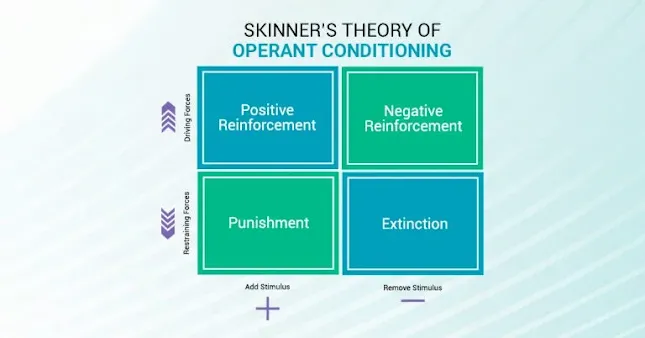Skinner’s Theory of Operant Conditioning: A Powerful Tool for Modern Learning
In the world of learning and development, understanding how people learn is just as important as what they learn. One of the most enduring and practical frameworks for shaping behavior and enhancing engagement is Skinner’s Theory of Operant Conditioning. Developed by renowned psychologist B.F. Skinner, this theory remains a cornerstone in behavioral psychology and continues to influence the design of effective training programs, especially in microlearning platforms like MaxLearn.
In this article, we’ll explore the key principles of operant conditioning, its relevance in modern training, and how MaxLearn applies these principles to drive better learner engagement, retention, and performance.
What is Operant Conditioning?
Operant conditioning is a learning process through which behaviors are influenced by their consequences. Unlike classical conditioning—which focuses on involuntary responses—operant conditioning is concerned with voluntary behaviors and how they can be increased or decreased through reinforcement or punishment.
B.F. Skinner categorized the consequences of behavior into four main types:
-
Positive Reinforcement – Adding a desirable stimulus to increase a behavior.
Example: Giving praise or rewards for completing a course. -
Negative Reinforcement – Removing an undesirable stimulus to increase a behavior.
Example: Removing an overdue training alert once the learner completes the task. -
Positive Punishment – Adding an undesirable stimulus to decrease a behavior.
Example: Displaying a warning message when a learner fails a module repeatedly. -
Negative Punishment – Taking away a desirable stimulus to decrease a behavior.
Example: Revoking access to advanced content due to non-completion of prerequisites.
At its core, operant conditioning is about shaping behavior through consequences—a concept that is easily translated into learning and development strategies.
Why Skinner’s Theory Matters in Learning and Development
Today’s L&D professionals are tasked with not only delivering content but also ensuring behavior change, skill development, and long-term retention. Skinner’s operant conditioning offers a practical and proven way to achieve this by reinforcing desirable learning behaviors and discouraging ineffective ones.
Key reasons why operant conditioning is relevant to L&D include:
-
It aligns with adult learning principles, which emphasize autonomy and the impact of consequences.
-
It supports personalized learning paths by adapting reinforcement strategies based on learner performance.
-
It enhances learner motivation through clear rewards and feedback loops.
-
It creates repeatable learning habits, which are crucial for long-term behavior change.
Reinforcement in Microlearning: A Perfect Fit
Microlearning—short, focused bursts of learning content—works exceptionally well with operant conditioning. In fact, microlearning platforms like MaxLearn are uniquely positioned to leverage reinforcement theory at scale.
Here’s how operant conditioning principles naturally align with microlearning:
1. Immediate Feedback
One of the most effective ways to reinforce behavior is through immediate feedback. Microlearning modules are designed to be short and interactive, allowing learners to receive instant feedback after each quiz, challenge, or decision point—thereby reinforcing correct behaviors and addressing incorrect ones in real-time.
2. Frequent Reinforcement Opportunities
Because microlearning is delivered in small units and consumed frequently, learners encounter more frequent reinforcement events. This repetition strengthens the association between learning behaviors and positive outcomes, accelerating mastery.
3. Gamification and Positive Reinforcement
MaxLearn’s gamified LMS takes advantage of operant conditioning by rewarding learners with points, badges, levels, or even recognition for desired behaviors like course completion, high scores, or streaks. This system of positive reinforcement taps into intrinsic motivation and keeps learners engaged.
4. Behavior Tracking and Adaptive Interventions
With built-in AI-powered tracking, MaxLearn can identify patterns of learner behavior and automatically adjust reinforcement strategies. For example, learners who consistently procrastinate may receive nudges or reminders (negative reinforcement), while high performers might unlock exclusive content or leaderboards (positive reinforcement).
Real-World Applications of Operant Conditioning in Training
Let’s consider some examples of how operant conditioning can be applied to real-world corporate training scenarios:
Compliance Training
-
Positive Reinforcement: Provide a digital certificate and public recognition on the company intranet when a compliance course is completed on time.
-
Negative Reinforcement: Remove overdue reminders once the course is completed.
Sales Training
-
Positive Reinforcement: Award a badge or offer access to a bonus course when a sales training module is completed with high accuracy.
-
Negative Punishment: Restrict access to advanced modules if basic ones are not completed.
Onboarding
-
Positive Reinforcement: Use welcome messages and progression bars to encourage new hires as they complete onboarding tasks.
-
Positive Punishment: Send follow-up tasks or additional assignments if mandatory onboarding content is skipped.
By designing training that rewards the right behaviors and discourages ineffective ones, organizations can drive measurable improvements in learning outcomes.
Avoiding Over-Punishment: Striking the Right Balance
While reinforcement is a powerful motivator, over-relying on punishment—especially negative punishment—can backfire. Learners may become disengaged, frustrated, or even resistant. That’s why MaxLearn emphasizes a positive learning environment that rewards progress rather than punishing mistakes.
The goal is to encourage consistent learning behavior by making the experience rewarding, enjoyable, and intrinsically motivating.
Operant Conditioning and Habit Formation
A key benefit of operant conditioning in training is its ability to form habits. Just like Skinner’s famous experiments with rats and pigeons showed how repeated reinforcement can shape behavior, microlearning platforms can reinforce learning habits over time.
For instance, MaxLearn’s AI-powered daily quizzes and spaced repetition techniques help learners build a daily learning routine. The consistency of reinforcement creates a learning habit loop: cue → behavior → reward.
Final Thoughts
B.F. Skinner’s theory of operant conditioning is far more than a historical concept in psychology—it’s a practical framework that empowers modern educators and L&D professionals to design more effective, engaging, and personalized learning experiences.
By applying operant conditioning through microlearning, gamification, adaptive learning, and reinforcement-driven content, platforms like MaxLearn ensure that learning is not only absorbed but also retained and applied on the job.
In a world where attention is limited and engagement is critical, understanding and utilizing behavioral science can make the difference between a forgettable training module and a transformative learning journey.
Explore how MaxLearn leverages Skinner’s principles to drive learning that sticks. Visit MaxLearn to learn more.


.jpg)



